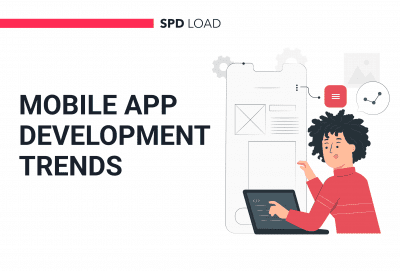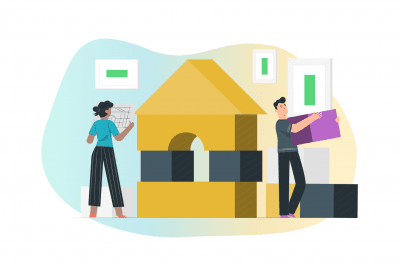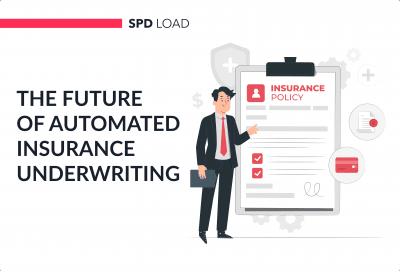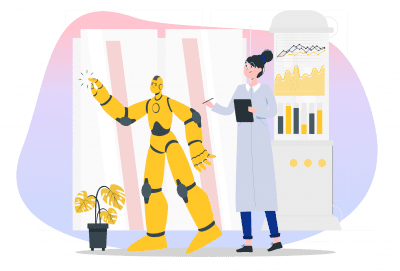4 Best Food Delivery Business Models in 2025
- Updated: Nov 12, 2024
- 12 min
The key to a successful food delivery model is to target the right customer niche. Today’s consumers expect fast, user-friendly online services.
The global food delivery market is projected to reach $182.3 billion by 2025, so choosing the right business model is critical for success.
However, developing a winning product won’t be easy. Fierce competition makes for an intense environment.
As a result, operating expenses may climb as more marketing efforts become necessary for impactful outreach.
That said, the initial step in any business is determining its model — and food delivery is no exception.
That’s why we’ll outline the most lucrative online food delivery business models in this guide.
Start delivering delicious results — discover how to create a food delivery app that customers love.
Start your journey with our expert developers today to bring your revolutionary idea into reality!
Why do Most Food Delivery Models Use Apps?
Not just a simple brick and mortar application, but you need a custom food delivery app for your business model.
There are several reasons why users are more inclined to use a mobile application like an order management system for ordering meals.
| Reasons | Description |
| Convenience | Convenience means a better customer experience. A PwC report finds that 86% of the consumers will happily pay more for better customer experience. Online food delivery can achieve success via business models that keep user-experience as the primary objective. Even small tweaks like keeping the “Add to Cart” within the thumbs reach is useful. Hence, your food delivery business model must adhere to such small improvisations. |
| Saves Time | A mobile phone’s easy reachability and fast processing allow the users to order food instantly. Due to this, any food ordering business model has a dedicated app for the customers. From the first step of login to payment, each step is included in the same application. 70% of the customers prefer seeing the restaurant’s menu on their mobile phone. Also, the end-user needs to order their favorite meal as fast as possible. That is why 25% of the users have more than one food ordering application on their phones. If one application is down or there are some issues, they switch to another application. |
| Mobile Penetration and Ease of Use | At present, 41.5% of the world population has access to smartphones. Thus, any food delivery model cannot survive without a mobile application. A food delivery app business model includes customer-centric features that help gain a better market share. Added to this, a mobile application is easier to use and engage with the service provider. The users can interact with your business anytime and anywhere. |
| The Appeal Factor | The methods and tactics to impress, attract, or appeal to your target market are numerous with an app. Your online food delivery business model can have loyalty programs and special discounts. Further, you can also add location-based recommendations for a personalized appeal. Starbucks sends push notifications to its users when they are nearby to an outlet. These factors help build a market presence for businesses. App check-in rewards, referral rewards, among others, can also be easily executed via an app. |
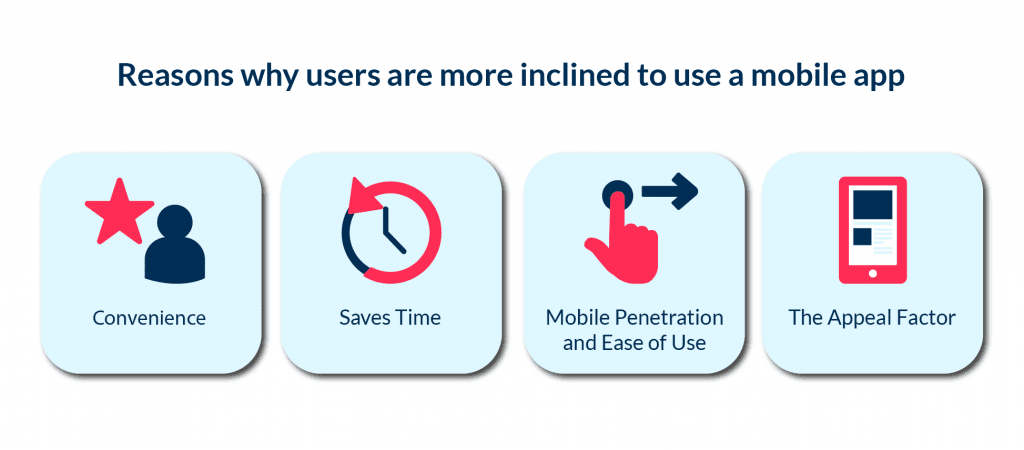
Apart from these major factors, a few other factors that ensure an application’s importance are:
- Interface
- Payment Systems
- Faster Performance
- Easy Visibility
- Can be downloaded
It is evident that any food delivery venture needs an app, let’s discuss some models that you can go for.
Choosing the Right Food Delivery Business Model
- DoorDash has a total value of $13 billion.
- UberEats’ total value is a whopping $20 billion
- Lastly, Postmates joined the billion-dollar club with a valuation of $1.85 billion.
To operate a successful food delivery business, you must choose the right model.
Read on to know about the top business models.
1. Order Only Model
As a starting point, the order-only model is an impressive food delivery business model.
Some might also call it a Platform to Consumer business model. In the US alone, the P2C segment is on its way to reaching $96,864 million by 2025.
The owner of the application connects the end-user with an eatery or a restaurant.
However, the onus of delivering the meals rests on the restaurant’s own fleet or any other 3rd party courier service provider.
Usually, you would have a vast network of restaurants enlisted in the application. Further, it is essential to provide the diverse menu options to the user via the app.
| Pros | Cons |
| This food delivery app business model is easy to start and has a lower capital requirement. | The meal options are limited in this model. You can only list those items that the restaurants can prepare. |
| No hassles of delivering or preparing the snacks or meals. | You cannot offer a higher price than what the restaurants charge. |
| Easy to Scale and grow as you only need to add more restaurants on your app. | No control over the food quality and courier standards. |
Main Challenges to Overcome
It may seem a simple process, but adding more restaurants is easier said than done. The success of this delivery model rests on food quality and restaurant listings.
Choosing not so popular eateries can reduce the usage metrics of your applications.
Since, 1/5th of the users have already set their preferences, the choice of restaurants matters.
Added to this, the entire market is competitive. The majority of the restaurants may already have an audience with the existing service providers.
So, convincing them might take the pitch of the century.
Ways to Overcome the Challenge?
- Develop your USP and share it with the restaurant owners.
- Run effective PR Campaigns targeting restaurants to enhance your outreach and awareness.
- Create your own Loyalty Programs to get more users.
How to Generate Cash?
| Monetization | Description |
| Commissions | The earning model of order only food delivery application rests majorly on commissions. The average commission for one order is between 10 to 15% of the total value. |
| Featured Restaurants | Once your application gains traction, allow the restaurants to come on top search results. In exchange for a top position, you can charge a monthly fee from the restaurant owners. |
Examples: Food delivery applications like Grubhub and Seamless work on this business model.
Either the restaurant has its own fleet, or they have tie-ups with 3rd party courier services.
Also, a good example of such a service is a Kharkiv-based delivery startup Easy Food.
An interesting feature of their business model is that the founders, before investing in the site, launched and optimized the blog to organically attract local customers who google “замовити вареники на дім Харків”.
Thus, the startup was able to gather a local audience, and on its basis build a profitable model from the first day of deliveries. 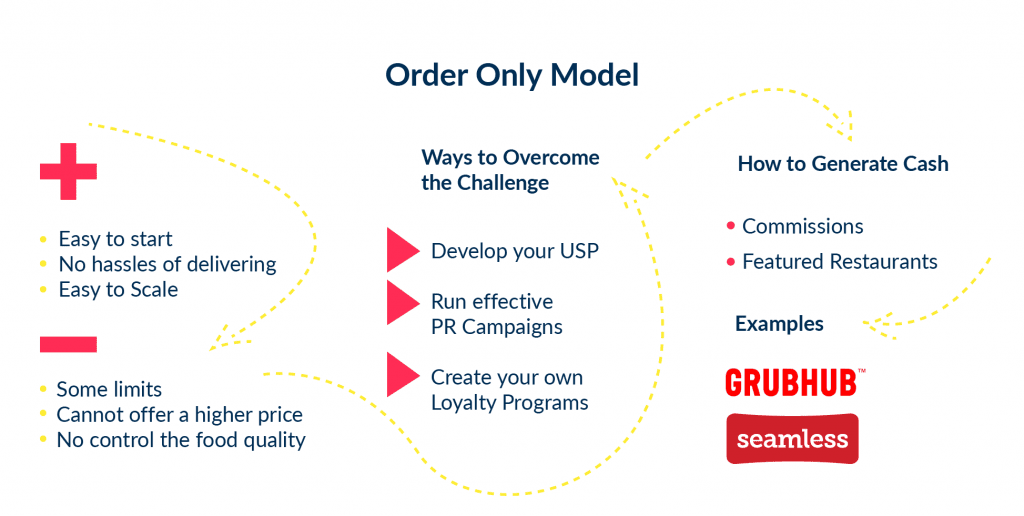
Looking to create a food app? Check out our comprehensive restaurant app development guide.
2. Order and Delivery Model
Going one step ahead of the order-only service, this food delivery model also takes care of the logistics.
For the restaurants, this kind of operational setup is ideal as they don’t have to look for courier guys.
The best part is that your business model will also bring its own user base along with operationalizing food delivery.
The pre-existing customer base is most beneficial for the restaurant owners.
Even though Grubhub (34%) leads the charts with the highest usage share in the US, UberEats (24%) bags the second position.
Out of them, UberEats works on the online food order and delivery business model.
The majority of the functioning of this type of food delivery app business model is similar to the previous version.
The delivery of food also rests on your shoulders; thus, establish high standards for this type of business model.
However, by including the transport aspect, you can also earn revenue from the customer side.
This kind of working model also consists of Milk-Run and Point to Point Deliveries.
Understanding ARR is essential for scaling. Use this ARR calculator to keep track of your performance.
| Type | Description |
| Point to Point | The central management panel utilizes a network of couriers. The couriers are present nearby to the eatery or a restaurant. Once the order is generated, the courier takes an order and brings it to the drop-off point. |
| Milk Run Delivery | This form of delivery model is not very conducive to the food segment. However, the basic framework is somewhat similar. The courier service provider has a network of deliveries lined up. One courier guy will take the order from a single unit and deliver it to different addresses. This kind of delivery model is operational in parcel and online shopping, but it is not observed in the food segment. |
| Pros | Cons |
| Higher potential to earn commissions as you take care of the major part of the value chain. | Scaling such a setup and infrastructure is not straightforward. |
| Once this sort of food delivery model is set up, you can generate more demand at will. | This food delivery business model is financially demanding and mentally taxing. |
| Restaurants tend to choose businesses that help them in transport and courier management. | At present, there are about 598 businesses in the US alone. This means that competition is tough and fierce. |
Main Challenge to Overcome
One of the greatest challenges for this type of food delivery app business model is setting up an effective transport fleet.
Not only effective, but it has to be swift, prompt, and address all the customer concerns.
As per a McKinsey Report, 60% of the customers choose a service provider based on its courier speed.
Higher food delivery time leads to an unsatisfied customer base, which degrades the business model’s profitability.
Ultimately, it will reduce your viewership, and the number of restaurants associating with your application might also plummet.
How to Overcome them?
- The timely distribution aspect is most important during lunch hours. As professionals and offices have a limited time frame.
- If delivery is becoming an issue, hire more guys to cover a larger city area.
- Try different modern food delivery ideas like via a drone and parachute.
How to Generate Cash?
| Monetization | Description |
| Commissions | Such food delivery business models have EBITDA margins of up to 57%. The major source of income in this food delivery model are commissions. They take a fixed percentage of commission from the restaurants. Added to this, you can also charge some fees from the customers for courier. Use this EBITDA business valuation calculator for accurate insights. |
| Subscriptions | You can also offer subscriptions to both the customers and restaurants.
Such an app business model makes food delivery ventures more lucrative. |
Examples: UberEats and Deliveroo are two of many online food delivery business models on these lines.
As you already may know, UberEats has its own fleet. They have set some delivery guidelines for a safer and faster service. 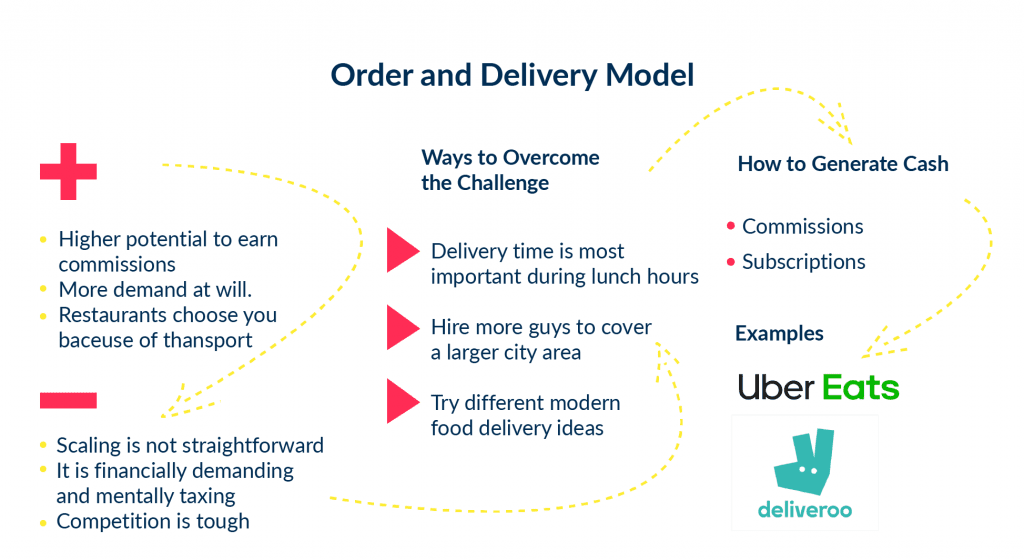
3. Fully Integrated Food Delivery Model
Also called the Full Stack Model, here one service provider takes care of the entire food chain.
Right from preparation to drop-off, this online food delivery business model is unique and warrants a high capital investment.
To prepare the food, you can further take two different routes:
- Set up your own kitchens and hire the entire staff.
- Hire cloud-kitchens or ghost kitchens. They will prepare the food that will be delivered to the customer under your banner.
However, the food preparation facilities are not open to a dine-in.
They are only responsible for preparing the food and handing it over to the delivery department.
In this food delivery business model, you will be responsible for maintaining quality standards.
Not just in the delivery aspect, but also in the preparation of the food too.
| Pros | Cons |
| Since it combines food delivery with other aspects makes this model a preferred avenue for investors. | The end-user is usually attached to a restaurant name and will tend to order from their favorite eatery. |
| You will have full control over the entire supply chain of the orders. | The startup cost of this business model is higher as it goes beyond the food delivery aspect. |
| No dine-in means the setup cost of a restaurant will be much less. | Managing the whole network of operations is complex. Inefficiency in any aspect can lead to low-quality service. |
Main Challenges to Overcome
Cost is one of the biggest challenges in this business.
Whereas the food delivery and other charges might be at par with others, the food preparation is an added aspect in this model.
Even if you can cover the cost aspect with funding or bootstrapping, acquiring the customers without a branded restaurant name is not easy.
People might like to change their food habits occasionally. Still, the basic premise is to try out new recipes, rather than new restaurants.
Lastly, the food delivery cost is also on the higher end in this business model.
Maple’s working model succumbed to this bottleneck of high courier cost and lower profits in food delivery.
They started losing money on every meal. And soon, the cumulative loss climbed to $9 million.
How to overcome them?
Well, getting the required funding depends on your initial investment and your ability to secure funds.
- The investor sentiment depends on the potential of your startup that is backed by an outstanding pitch.
- The convergence of all three segments of the online food delivery business model is what interests the investors.
Dahmakan, which has a similar food delivery model, is working in Malaysia. And just recently, it has secured $18 million in Series B funding.
For getting the customers:
- Provide high-quality standards of food.
- Run effective PR campaigns.
- Give out discounts and promotional offers.
- Use social media channels to your benefit.
How to Generate Cash
Since the entire management of services and deliveries is under your control, generating revenue from this model is easy.
More importantly, food delivery resting on a comprehensive model paves the way for a higher profit.
| Monetization | Description |
| Service Charges | Along with the profit earned on food delivery, you can also put an extra service charge in this business model. This charge can be in the form of priority deliveries or even a subscription for free deliveries. |
| Profit Generation | The potential to scale in such a food delivery business model is huge. If you are able to market your service with efficiency and use technology to your benefit, it is possible to build a mammoth business. |
| Special Packages | Since you will be taking care of the entire network of operations, it is easier to leverage from high-earning opportunities. You can take special orders or go for a meal-kit food delivery model. Taking orders in high volume from corporates and other businesses is something that you can consider. |
Examples: Two major food delivery services Munchery and Maple saw failure in this business model as they were cash-burners.
However, a few other online food delivery services working on this business model.
But, they have augmented their operations with additional businesses.
Luke’s Local also offers door to door grocery delivery.
Along with this, you can also check out Thistle, but their operations are limited to some specific areas in the Bay. 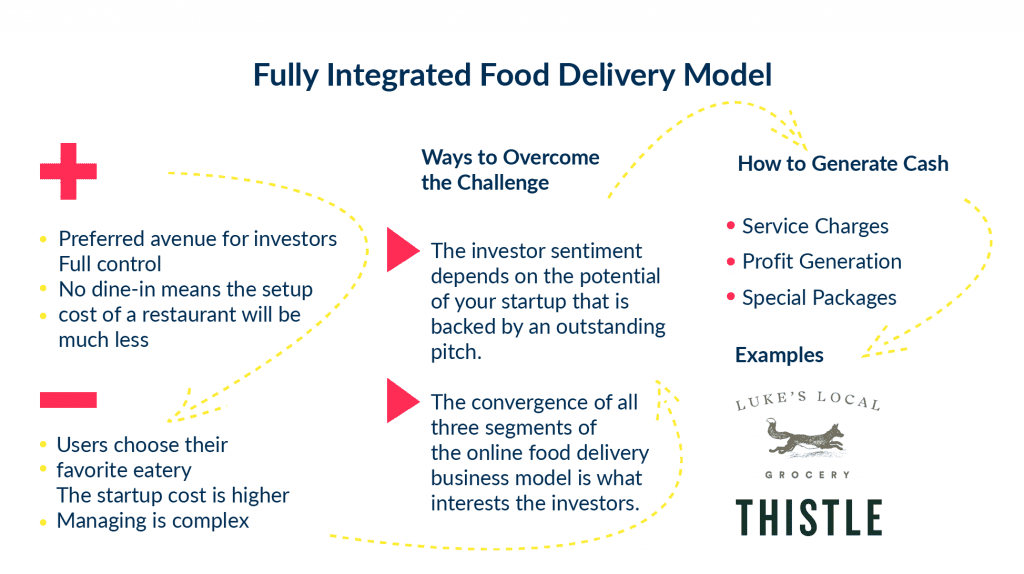
4. Restaurant-to-Consumer Model
The last major type of business model that you can have in food delivery is taking the food your restaurant to the drop off point.
By far, this is one of the most successful food delivery business models, case in point, Dominos and Papa John’s.
Such a business model requires developing a platform-specific food delivery app. Apart from this, they also have a website to help the customers place orders.
According to Statista, the restaurant’s overall market share of the consumer food delivery business model will reach $85,500 by 2025.
The on-demand food delivery models and systems have pushed other businesses.
They have motivated them to change or modify their digital strategies.
| Pros | Cons |
| In this model, you can set a price monopoly for food delivery. As of 2019, Domino’s revenue was $3.62 billion in the US. | Running and maintaining this food delivery app business model is complex. Other than this, such ventures are cash burners. |
| Complete freedom to alter your menu as per the customer demand. | Where it is feasible to set your monopoly, it is equally complex to enter a monopolistic competition. |
| Such delivery models have a huge potential to scale and capture other markets. |
Main Challenges to Overcome
The Restaurant to Consumer food delivery business model warrants a huge capital investment.
Without a set and well-established food outlet, it is not easy to compete with the giants like Dominos or Papa John’s.
The market is already saturated with several brands. Hence, you need to find your place in this highly competitive market.
So, setting up shop in such an environment won’t be easy.
How to Overcome them?
- Restaurant to Consumer food delivery business model can consist of partnering with the on-demand models. For instance, as a restaurant, you can have your own application for ordering.
- You can also associate with organizations following on-demand online food delivery business model. For the ordering part, you can take their assistance in exchange for a commission.
- On your part, you can handle the food delivery and preparation in this model.
- Focus on setting up your operations and generating orders via another application. Once your brand has its own audience, launch your own application.
How to generate cash?
| Monetization | Description |
| Profit Margin | In this business model, you have control over food delivery and quality. Due to this, you can set your own prices and benefit from a higher profit margin. |
| Mergers and Acquisitions | As per analysts, the food delivery market has fierce competition. Hence, businesses can generate more profit by merging with other business models. This will help them get a wider market share and more profits. |
Example: Domino’s, Papa John, Pizza Hut, McDonald’s, and many more. 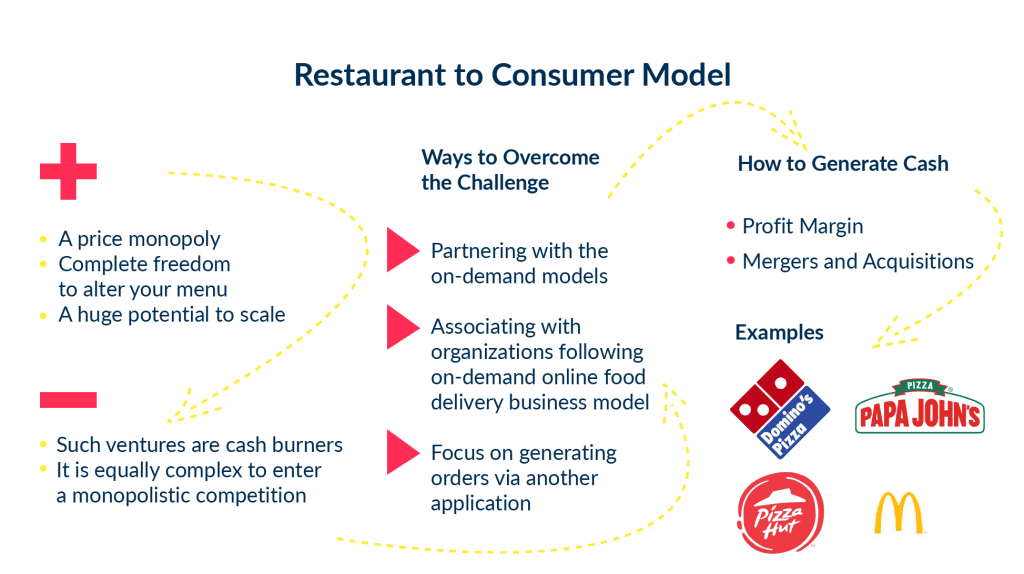
Want to Build Your Own Food Delivery Business?
Looking to build an app for your food delivery business? As the on-demand food delivery market heads towards a value of $365 billion by 2030, now is the perfect time to create a custom solution.
A tailored app underscores your brand’s uniqueness—setting you apart in this competitive industry.
Our end-to-end development services, spanning ideation, design, coding, and launch support, are crafted to help your business get ahead.
With extensive experience building and scaling on-demand apps, our experts become an extension of your team. We’ll collaborate with you to turn your vision into reality.
Being a Clutch Leader in Ukraine speaks to our dedication and hard work in the software development field.
Reach out today to learn more about our development process and how we can translate your ideas into a seamless, intuitive product.




